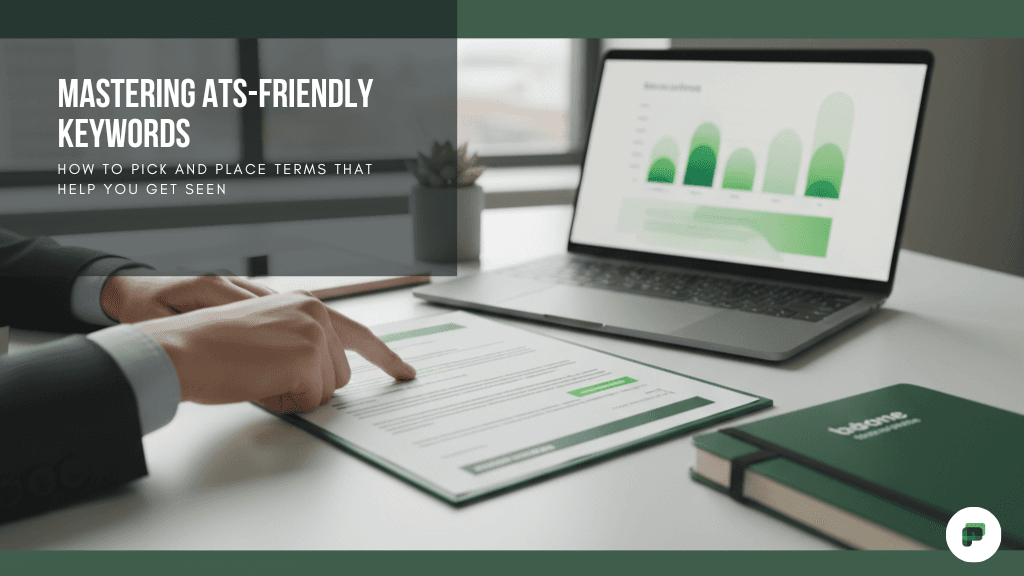The Ultimate Guide to Resume Keywords: How to Get Past the ATS


Sneha Satapathy
The Ultimate Guide to Resume Keywords: How to Get Past the ATS
Category: Resume Building Keywords: resume keywords, ATS-friendly resume, resume tailoring
In today's competitive job market, landing your dream role requires more than just a strong skill set and impressive experience. Before your carefully crafted resume even reaches a human recruiter, it often faces its first, and perhaps most formidable, gatekeeper: the Applicant Tracking System (ATS).
An ATS is a software application designed to streamline the recruitment process. While incredibly efficient for companies, for job seekers, it can feel like navigating a complex maze where one wrong turn means your application is discarded. The key to successfully navigating this maze? Resume keywords.
This ultimate guide will demystify resume keywords, explain why they're critical, and provide actionable strategies to optimize your resume, ensuring it not only passes the ATS but also captures the attention of human eyes.
What is an ATS and Why Does it Matter?
Imagine a large corporation receiving hundreds, sometimes thousands, of applications for a single opening. Manually sifting through each resume is simply not feasible. This is where the ATS comes in.
An Applicant Tracking System (ATS) is a software solution used by over 98% of Fortune 500 companies to manage the entire recruiting and hiring process. Its primary functions include:
- Collecting Applications: Centralizing resumes and cover letters.
- Parsing Information: Extracting key data (e.g., contact info, work history, skills) into a standardized format.
- Keyword Filtering: Scanning resumes for specific keywords and phrases relevant to the job description.
- Ranking Candidates: Assigning a relevancy score to each application based on keyword matches and other criteria.
- Filtering Out Unsuitable Resumes: Automatically rejecting applications that don't meet minimum keyword thresholds, often before a human ever sees them.
The stark reality is that if your resume isn't optimized for the ATS, it could be among the estimated 75% of applications that are rejected automatically. This highlights precisely why understanding and strategically deploying keywords is not merely an advantage—it's a necessity.
The Power of Keywords: More Than Just Buzzwords
Keywords are specific words and phrases that recruiters and hiring managers use to describe job requirements, skills, and responsibilities. For the ATS, they are the breadcrumbs that lead it to identify a relevant candidate. They fall into several crucial categories:
-
Hard Skills (Technical Skills): These are measurable, teachable abilities acquired through training or experience. For professionals in AI, data science, machine learning, and software engineering, these are paramount.
- Examples: Python, SQL, Java, C++, JavaScript, R, TensorFlow, PyTorch, Scikit-learn, AWS, Azure, Google Cloud Platform (GCP), Docker, Kubernetes, Git, Apache Spark, Hadoop, Data Visualization, Machine Learning, Deep Learning, Natural Language Processing (NLP), Computer Vision, Agile, Scrum, RESTful APIs, System Design.
-
Soft Skills (Transferable Skills): While harder to quantify, these are essential interpersonal and personal attributes that enable effective work.
- Examples: Problem-solving, Critical Thinking, Communication, Collaboration, Leadership, Adaptability, Project Management, Time Management, Data Analysis, Strategic Planning, Innovation.
-
Action Verbs: These powerful verbs describe your accomplishments and responsibilities in an impactful way. They provide context for your skills and experiences.
- Examples: Developed, Implemented, Analyzed, Managed, Optimized, Designed, Led, Built, Engineered, Quantified, Improved, Solved, Streamlined, Collaborated.
-
Industry-Specific Terminology: Jargon and specific terms unique to your field or a particular company's operations.
- Examples: Big Data, MLOps, A/B Testing, Predictive Modeling, Reinforcement Learning, Cloud Native, Microservices, Data Governance, ETL processes.
How to Identify the Right Keywords for YOUR Resume
Finding the right keywords isn't about guessing; it's about strategic analysis. Here’s a data-driven approach:
1. Analyze the Job Description (The Gold Standard)
This is your primary source of truth. Every job description is a treasure map to the keywords the hiring team and, consequently, the ATS are looking for.
- Read Meticulously: Go through the job description line by line. Highlight or list all skills, tools, technologies, methodologies, and responsibilities mentioned.
- Frequency Matters: Pay close attention to terms that appear multiple times. If "Python" is listed under required skills, responsibilities, and preferred qualifications, it's a critical keyword.
- Exact Phrasing: Note exact phrases like "data warehousing" or "full-stack development." The ATS is often programmed to look for exact matches.
- Required vs. Preferred: Prioritize "required" skills, but incorporate "preferred" ones if you possess them.
Example: If a job description for a "Senior Machine Learning Engineer" repeatedly mentions "TensorFlow," "PyTorch," "AWS," "deploying models," and "Python," these must be prominently featured in your resume.
2. Research Industry Trends & Common Terms
Beyond a single job post, understanding broader industry language can give you an edge.
- LinkedIn: Look at profiles of people currently in roles you aspire to. What skills do they list? What technologies are trending?
- Company Website/Blog: Familiarize yourself with the company's language, products, and tech stack.
- Industry Publications/Conferences: Stay updated on emerging technologies and standard terminology in your field (e.g., arXiv for AI research, IEEE publications for engineering).
3. Leverage Synonyms & Related Terms
While ATS can be rigid, some are smart enough to recognize synonyms. It's good practice to include variations if space allows.
- "Machine Learning" vs. "ML"
- "JavaScript" vs. "JS"
- "Database" vs. "DB," "SQL" vs. "Structured Query Language"
- "Project Management" vs. "PM"
However, always prioritize the exact phrasing from the job description first.
Strategic Placement: Where to Sprinkle Your Keywords
Once you've identified your target keywords, the next step is to integrate them naturally and effectively throughout your resume.
-
Resume Summary/Objective (Top of the Funnel):
- This is often the first section an ATS scans. Make it keyword-rich.
- Craft a concise paragraph (or two) that summarizes your most relevant skills, experience, and career goals, incorporating 5-7 key terms directly from the job description.
- Example: "Highly skilled Machine Learning Engineer with 5+ years of experience in Python and TensorFlow, specializing in NLP model development and AWS cloud deployments."
-
Skills Section (The ATS Checklist):
- This is perhaps the most critical section for ATS optimization.
- Create a dedicated skills section, often categorized (e.g., Programming Languages, Frameworks, Cloud Platforms, Tools, Methodologies).
- List all relevant keywords here. Use bullet points for readability.
- Example:
- Programming Languages: Python, Java, C++, Go, R
- ML Frameworks: TensorFlow, PyTorch, Keras, Scikit-learn
- Cloud Platforms: AWS (EC2, S3, SageMaker), Azure, GCP
- Databases: SQL, NoSQL, MongoDB, PostgreSQL
- Tools: Docker, Kubernetes, Git, Jira, Tableau
-
Experience Section (Context and Proof):
- Integrate keywords organically into your bullet points describing responsibilities and achievements.
- Use strong action verbs to start each bullet point, followed by the keyword, and quantify your achievements whenever possible.
- Example (Before): "Worked on data models."
- Example (After): "Developed and optimized predictive machine learning models using Python and Scikit-learn, resulting in a 15% improvement in forecast accuracy."
- Example (After): "Engineered scalable backend APIs with Node.js and MongoDB, supporting over 10,000 concurrent users and enhancing system performance by 20%."
-
Education Section & Projects (Relevant Courses/Applications):
- If you're a recent graduate, include relevant coursework or capstone projects where you used specific technologies or methodologies.
- For personal projects, explicitly list the technologies used and the problem you solved.
- Example: "M.S. in Computer Science (Specialization: Artificial Intelligence), University X. Relevant coursework: Deep Learning, Natural Language Processing, Reinforcement Learning."
Avoiding Common Keyword Stuffing Pitfalls
While keywords are vital, quantity does not always equal quality. Over-optimizing can backfire.
- Don't Keyword Stuff: Repeating the same keyword excessively (e.g., "Python, Python, Python...") looks unnatural and can be flagged by ATS or, more importantly, human recruiters as spammy.
- Context is Key: Keywords must be used within meaningful sentences that showcase your skills in action. A list of disconnected words is less effective than integrated accomplishments.
- Readability Matters: Always prioritize clarity and flow for the human reader. If a human can't understand your resume, it doesn't matter how well the ATS ranked it.
- Don't Use Hidden Text: Avoid placing keywords in tiny font sizes, white font on white background, or outside the visible margins. This black-hat tactic is easily detected by modern ATS and will likely lead to immediate rejection.
The Continuous Learning Loop: Keeping Your Resume Current
The fields of AI, data science, machine learning, and software engineering are rapidly evolving. New frameworks emerge, existing tools gain or lose prominence, and industry best practices shift.
- Industry Evolution: What was a cutting-edge skill five years ago might be foundational today. Continuously update your knowledge and, consequently, your resume's keywords.
- Regular Updates: Treat your resume as a living document. For each new application, re-tailor it to the specific job description. Don't use a generic resume.
- Feedback & Iteration: If you're not getting interview calls despite being qualified, analyze the job descriptions you applied to and compare them with your resume. Seek feedback and iterate on your keyword strategy.
Conclusion
In the digital age of recruitment, understanding and mastering resume keywords is no longer optional; it's a fundamental skill for job seekers. By meticulously analyzing job descriptions, strategically integrating relevant terms, and avoiding common pitfalls, you can ensure your resume not only sails through the ATS but also presents a compelling, tailored narrative to the human beings who will ultimately make the hiring decision.
Start optimizing your resume today. The more precise and targeted your keywords, the closer you get to your next career opportunity.

Sneha Satapathy
Related Articles

Resume, Cover Letter and Interview Tips for Getting Hired as a Non‑German Speaking Expat in Germany
You can get a job in Germany without speaking German by targeting English-friendly companies, using a German-style CV, writing tailored cover letters, and preparing for direct interview styles. Focus on tech hubs like Berlin and Munich. Show willingness to learn German and use tools like Prepzo AI to optimize your CV and practice interviews for better chances.
Abhishek Singla

Healthcare Industry-Specific Resume Templates: Your Path to Medical Excellence
Showcase not just your medical knowledge but also your ability to work in high-pressure environments, collaborate with multidisciplinary teams, and maintain the highest standards of patient care
Sneha Satapathy

Finance Industry-Specific Resume Templates: Copy-Paste Samples to Land Interviews
Copy-paste finance resume templates plus tips for ATS-friendly, professional resumes.
Sneha Satapathy